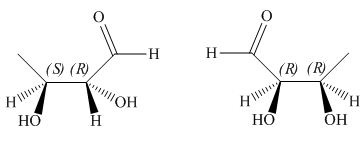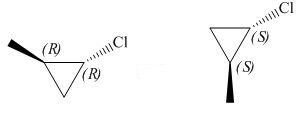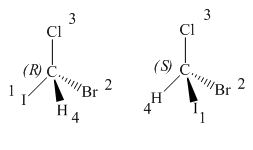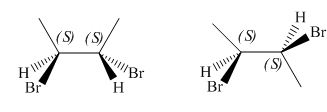
Concept explainers
(a)
Interpretation: The relation between given pair of compounds is to be determined.
Concept introduction: The stereogenic centers with
Enantiomer of a compound has opposite configuration at stereogenic centers. Diastereomers of a compound have at least one stereogenic centre with same configuration and at least one with opposite configuration.
Answer to Problem 5.62P
The given pair of compounds is enantiomers.
Explanation of Solution
The given pair of compounds is,

Figure 1
The given compounds have same connectivity of atoms or groups but have opposite configuration at the stereogenic centre. Hence, the given pair of compounds is enantiomers.
The given pair of compounds is enantiomers.
(b)
Interpretation: The relation between given pair of compounds is to be determined.
Concept introduction: The stereogenic centers with
Enantiomer of a compound has opposite configuration at stereogenic centers. Diastereomers of a compound have at least one stereogenic centre with same configuration and at least one with opposite configuration.
Answer to Problem 5.62P
The given pair of compounds is constitutional isomers.
Explanation of Solution
The molecular formula of both given compounds is
The given pair of compounds is constitutional isomers.
(c)
Interpretation: The relation between given pair of compounds is to be determined.
Concept introduction: The stereogenic centers with
Enantiomer of a compound has opposite configuration at stereogenic centers. Diastereomers of a compound have at least one stereogenic centre with same configuration and at least one with opposite configuration.
Answer to Problem 5.62P
The given pair of compounds is diastereomers.
Explanation of Solution
The given pair of compounds is,

Figure 2
The given compounds have one stereogenic centre with same configuration and one with opposite configuration as shown in Figure 2. Hence, the given pair of compounds is diastereomers.
The given pair of compounds is diastereomers.
(d)
Interpretation: The relation between given pair of compounds is to be determined.
Concept introduction: The stereogenic centers with
Enantiomer of a compound has opposite configuration at stereogenic centers. Diastereomers of a compound have at least one stereogenic centre with same configuration and at least one with opposite configuration.
Answer to Problem 5.62P
The given pair of compounds is not isomers of each other.
Explanation of Solution
The molecular formula of given compounds is different from the each other. The molecular formula of one is
The given pair of compounds is not isomers of each other.
(e)
Interpretation: The relation between given pair of compounds is to be determined.
Concept introduction: The stereogenic centers with
Enantiomer of a compound has opposite configuration at stereogenic centers. Diastereomers of a compound have at least one stereogenic centre with same configuration and at least one with opposite configuration.
Answer to Problem 5.62P
The given pair of compounds is enantiomers.
Explanation of Solution
The given pair of compounds is,

Figure 3
The given compounds have opposite configurations at the two stereogenic centre as shown in Figure 3. Hence, the given pair of compounds is enantiomers.
The given pair of compounds is enantiomers.
(f)
Interpretation: The relation between given pair of compounds is to be determined.
Concept introduction: The stereogenic centers with
Enantiomer of a compound has opposite configuration at stereogenic centers. Diastereomers of a compound have at least one stereogenic centre with same configuration and at least one with opposite configuration.
Answer to Problem 5.62P
The given pair of compounds is enantiomers.
Explanation of Solution
The given pair of compounds is,

Figure 4
In the given compounds,
Thus, the two compounds have opposite configurations. Hence, the given pair of compounds is enantiomers.
The given pair of compounds is enantiomers.
(g)
Interpretation: The relation between given pair of compounds is to be determined.
Concept introduction: The stereogenic centers with
Enantiomer of a compound has opposite configuration at stereogenic centers. Diastereomers of a compound have at least one stereogenic centre with same configuration and at least one with opposite configuration.
Answer to Problem 5.62P
The given pair of compounds is identical.
Explanation of Solution
The given pair of compounds is,

Figure 5
The given compounds have same connectivity and same configurations at the two stereogenic centre as shown in Figure 5. Hence, the given pair of compounds is identical.
The given pair of compounds is identical.
(h)
Interpretation: The relation between given pair of compounds is to be determined.
Concept introduction: The stereogenic centers with
Enantiomer of a compound has opposite configuration at stereogenic centers. Diastereomers of a compound have at least one stereogenic centre with same configuration and at least one with opposite configuration.
Answer to Problem 5.62P
The given pair of compounds is diastereomers.
Explanation of Solution
The given pair of compounds is,

Figure 6
The given compounds have one stereogenic centre with same configuration and one with opposite configuration as shown in Figure 6. Hence, the given pair of compounds is diastereomers.
The given pair of compounds is diastereomers.
(i)
Interpretation: The relation between given pair of compounds is to be determined.
Concept introduction: The stereogenic centers with
Enantiomer of a compound has opposite configuration at stereogenic centers. Diastereomers of a compound have at least one stereogenic centre with same configuration and at least one with opposite configuration.
Answer to Problem 5.62P
The given pair of compounds is diastereomers.
Explanation of Solution
The given pair of compounds is,

Figure 7
Two methyl groups present on the six membered ring are above the plane. However, the methyl groups of chair conformation are present trans to each other. Therefore, the given pair of compounds represents diastereomers.
The given pair of compounds is diastereomers.
(j)
Interpretation: The relation between given pair of compounds is to be determined.
Concept introduction: The stereogenic centers with
Enantiomer of a compound has opposite configuration at stereogenic centers. Diastereomers of a compound have at least one stereogenic centre with same configuration and at least one with opposite configuration.
Answer to Problem 5.62P
The given pair of compounds is constitutional isomers.
Explanation of Solution
The given pair of compounds is,

Figure 8
In the given compounds, the position of
The given pair of compounds is constitutional isomers.
Want to see more full solutions like this?
Chapter 5 Solutions
Organic Chemistry-Package(Custom)
- Show the mechanism steps to obtain the lowerenergy intermediate: *see imagearrow_forwardSoap is made by the previous reaction *see image. The main difference between one soap and another soap isthe length (number of carbons) of the carboxylic acid. However, if a soap irritates your skin, they mostlikely used too much lye.Detergents have the same chemical structure as soaps except for the functional group. Detergentshave sulfate (R-SO4H) and phosphate (R-PO4H2) functional groups. Draw the above carboxylic acidcarbon chain but as the two variants of detergents. *see imagearrow_forwardWhat are the reactions or reagents used? *see imagearrow_forward
- The two pKa values of oxalic acid are 1.25 and 3.81. Why are they not the same value? Show the protontransfer as part of your explanation. *see imagearrow_forwardасть Identify all the bonds that gauche interact with C-OMe in the most stable conformation of the above compound.arrow_forwardPredict the reactants used in the formation of the following compounds using Acid-Catalyzed dehydration reactionarrow_forward
- Can I please get help with this?arrow_forward.. Give the major organic product(s) for each of the following reactions or sequences of reactions. Show ll relevant stereochemistry [3 ONLY]. A H Br 1. NaCN 2 NaOH, H₂O, heat 3. H3O+ B. CH₂COOH 19000 1. LiAlH4 THF, heat 2 H₂O* C. CH Br 1. NaCN, acetone 2 H3O+, heat D. Br 1. Mg. ether 3. H₂O+ 2 CO₂ E. CN 1. (CH) CHMgBr, ether 2 H₂O+arrow_forwardAssign this COSY spectrumarrow_forward
 Organic Chemistry: A Guided InquiryChemistryISBN:9780618974122Author:Andrei StraumanisPublisher:Cengage Learning
Organic Chemistry: A Guided InquiryChemistryISBN:9780618974122Author:Andrei StraumanisPublisher:Cengage Learning Chemistry for Today: General, Organic, and Bioche...ChemistryISBN:9781305960060Author:Spencer L. Seager, Michael R. Slabaugh, Maren S. HansenPublisher:Cengage Learning
Chemistry for Today: General, Organic, and Bioche...ChemistryISBN:9781305960060Author:Spencer L. Seager, Michael R. Slabaugh, Maren S. HansenPublisher:Cengage Learning

